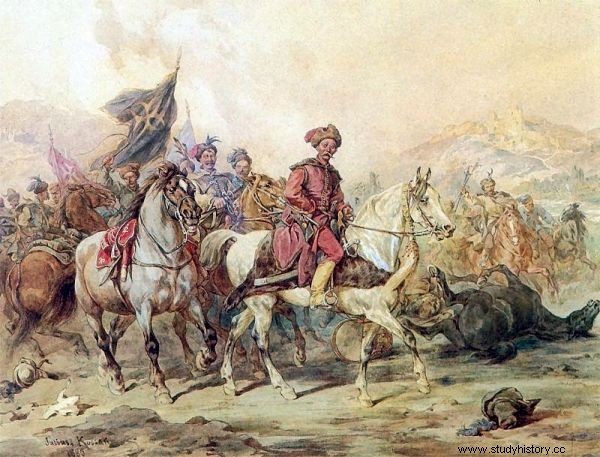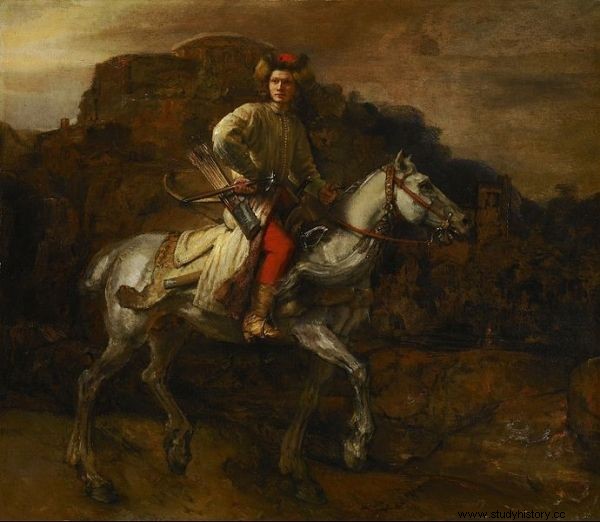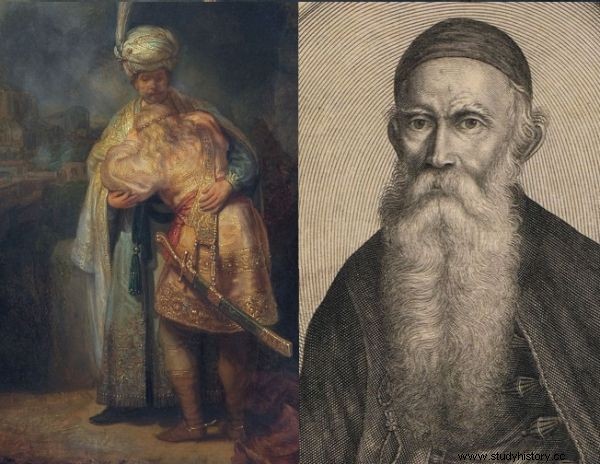During the Thirty Years' War, the Lisowians ventured as far as the Rhine. Did they get under the skin of the inhabitants of the Netherlands so much that one of the famous mercenaries was painted by Rembrandt? Or maybe the master disguised the true meaning of the painting?
Rembrandt's famous painting "The Polish Rider", now in the Frick Collection in New York, was probably created around 1655. It shows a cavalryman with the appearance of a Lisowczyk. In those years, this formation did not exist anymore, but the then Polish light cavalry looked similar. In addition, Europe remembered the exotic, but hellishly dangerous zagończyks who ventured to the West during the Thirty Years' War (1618-1648). Mothers scared the children with them . Baroque poet Józef Bartłomiej Zimorowic wrote:"They are rightly afraid of you, they are rightly afraid of you / they rightly call you a strange vengeance of God" ...
Horsemen of the Apocalypse
These Polish condottiers visited the Netherlands in 1622 and in the years 1635-1636 (when in the Polish-Lithuanian Commonwealth the Seym had already ordered their troops to be dissolved). They have earned a reputation for being incredibly bold and brave, though insubordinate, prone to loot and cruelty. After all, people used to say in the Commonwealth itself:"What a rogue is a Lisowczyk"!

The foxes according to Juliusz Kossak…
In the Netherlands, as everywhere in the Thirty Years' War, they were feared. Of course, especially among Protestants, because the Lisów people fought on the imperial side (although they also happened to loot Catholics). "They gave many Luthers to the devils as a sacrifice" - Zimorowice wrote not for nothing. Rembrandt (born 1606) may have come across the Lisowczyk family when they visited his homeland for the last time.
He could also see a similar looking Polish cavalryman much later. The question, however, is why he, a resident of a Protestant country, portrayed a Catholic soldier - and not in the form of a caricature? They shouldn't be too familiar to him.
Second bottom
You can imagine that he is a Polish rider who once wanted to go (no matter why, even for an appropriate sum) to the Protestant side. But would that be the subject of the painting? Or maybe it was a Polish nobleman who commissioned his portrait to be painted as a Lisowczyk (after all, we have a painting by Rembrandt, allegedly depicting Andrzej Rey, a diplomat, Calvinist activist and secretary of King Władysław IV). Only who would like to spoil their image, since there was a saying in the homeland "What a rogue is a lisowczyk" ?

... and Rembrandt's "Lisowczyk".
Art historian Jan Białostocki suggested a completely new lead. He pointed out that the title "Polish Jeździec" is Latin for "Eques Polonus". Under this pseudonym in 1654 he published in Amsterdam a work entitled "Apologia" a certain Jonasz Szlichtyng. He was one of the leaders of the Polish brethren, otherwise known as the Socinians or the Arians. This reformation religious movement became more and more hated in the Commonwealth (which led to their expulsion in 1658), and its enemies were Catholics, Calvinists and Lutherans. However, he had a great influence on libertarian ideas in the West. He drew from the works of Szlichtynga, among others John Locke!
In 1653, the Dutch States General forbade preaching the teachings of the Polish brothers. It was in response to this act that Szlichtyng published a year later, as "Eques Polonus", a treatise on tolerance and the separation of churches and the state. According to the hypothesis of prof. Białostocki, the rider from Rembrandt's painting would be an apotheosis of this Polish freedom swordsman. We should add that the word "tolerance" was not known to the Loxovites, and the Socynians were oppressed. In 1623, Raków, one of the main seats of the Arians, invaded Poland! Such a counterpoint would add even more spice to this performance…
Master's tail
But why should Rembrandt sympathize with the Polish brothers? We are not sure about his religious beliefs. He was a child of the Reformation, allegedly leaning towards the Mennonites, but undoubtedly he also had Arian friends. “Dutch historians of religion and art in general tend to believe that Rembrandt felt sympathy for the Polish brethren because of their naturalistic conception of religion and Jesus. Even in these circles the question is raised:was Rembrandt a Socinian? " - writes Arian historian Zenon Gołaszewski. Like the Polish brothers, the painter renounced the traditional concept of the Holy Trinity, and presented Jesus from a very human side.

"David's farewell to Jonathan" (left) and Jonasz Szlichtyng himself (right).
Or maybe the truth about the painting is even more complicated? In the background of the "Polish Rider" we see an object resembling a building from another painting by the master, entitled "David's farewell to Jonathan" (1642). There are also a saber, a bow and a quiver with arrows in the painting, almost like in the case of the Lisowczyk. Jonathan, son of the biblical King Saul (with whom he fell in battle), was also a friend of David, the future ruler of Israel. Maybe this "Jonathan" is a Lisowczyk in the later picture? Only who is it picturing? Jonathan is - unfortunately - but not Jonah…
Or is another title of Rembrandt's painting from 1642 more appropriate:"The Return of the Prodigal Son"? Then the Lisowczyk from "Polish Rider" could be the man returning to his homeland after years of wandering and losing everything he had. On an emaciated and panting horse, which is - as Prof. Żygulski - "a faithful representative of those horses that served in the beds and driveways, but which were often driven to death by the foxes and their successors". Scam this Rembrandt! He did nothing to help us read his intentions unambiguously.
More unknown Polish tropes from world history can be found in Adam Węgłowski's book "A very Polish history of everything".
